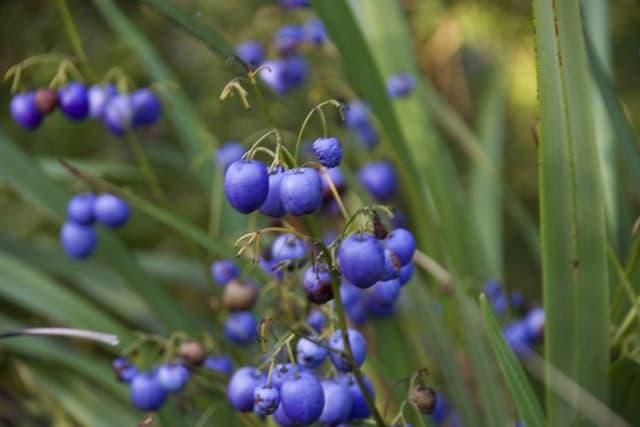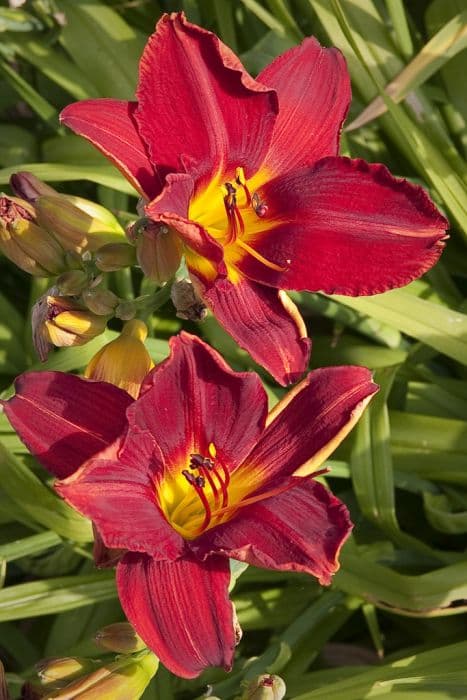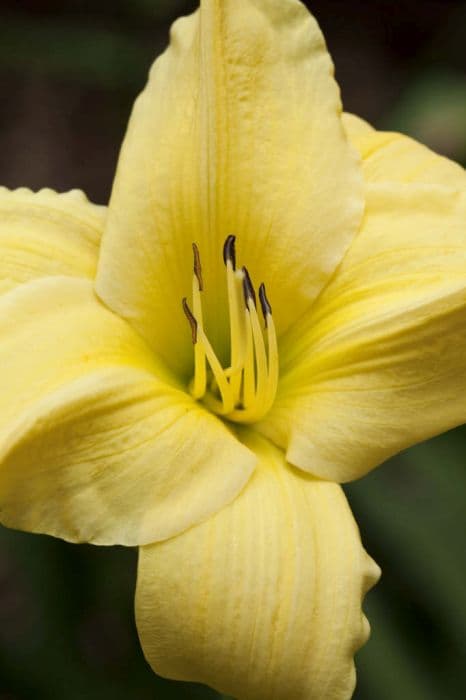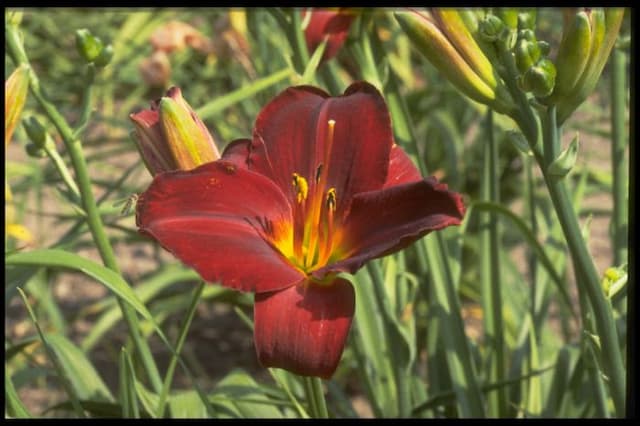Daylily Hemerocallis 'Be Bop a Lula'

ABOUT
The Hemerocallis 'Be Bop a Lula', commonly known as the Daylily, is a perennial garden plant that is appreciated for its striking flowers. This Daylily is characterized by its vibrant blooms, which typically exhibit a rich blend of colors. The flowers are often large and showy with a trumpet-like shape that opens wide at the mouth. The petals can be ruffled or smooth-edged and may have a variety of patterns including eye zones or picotee edges, where the color along the margins differs from the rest of the petal. The color palette of the 'Be Bop a Lula' Daylily is diverse and may include shades of yellow, red, purple, pink, and orange, often with contrasting throats or midribs that add depth and visual interest. The blossoms are borne on long, sturdy stalks which rise above the foliage, making the flowers stand out in the landscape. The foliage consists of long, slender leaves that are grass-like in appearance and arch gracefully. These leaves are a rich green color, forming a dense clump that serves as an attractive backdrop for the colorful blooms. The foliage typically emerges in early spring and persists well into the fall, providing a lengthy season of greenery. Daylilies like 'Be Bop a Lula' are known for their hardiness and low maintenance, making them favorites in gardens where reliable color and form are desired without constant care. Their bloom period extends over several weeks in the summer, with each individual flower lasting only a day, hence the name "Daylily." However, the profusion of buds ensures a continuous display of blossoms during their flowering season. These plants can serve multiple functions in a landscape, including working as border plants, groundcovers, or as eye-catching focal points. With their lush foliage and vivid blooms, Daylilies bring life and color to gardens, and 'Be Bop a Lula' is no exception, offering gardeners a delightful burst of color and an engaging display of blooms each year.
About this plant
 Names
NamesFamily
Hemerocallidaceae
Synonyms
Daylily
Common names
Hemerocallis 'Be Bop a Lula'.
 Toxicity
ToxicityTo humans
The plant commonly known as daylily, Hemerocallis 'Be Bop a Lula', is not typically considered toxic to humans. In fact, certain parts of the daylilies are edible and have been consumed in various cultures. However, it's important to note that eating any plant not widely recognized as an edible species should be done with caution, and one should always verify that the specific variety is safe to eat before consumption. As far as common knowledge goes, ingestion of this plant by humans does not usually lead to poisoning or notable symptoms of toxicity.
To pets
The plant commonly known as daylily, Hemerocallis 'Be Bop a Lula', is known to be toxic to cats, and possibly to other pets. Ingesting this plant can cause serious health issues for cats, including kidney failure. Symptoms of daylily poisoning in cats may include vomiting, lethargy, lack of appetite, and increased urination followed by a lack of urination. If a cat ingests any part of a daylily, it is considered a medical emergency, and immediate veterinary attention is required. For other pets, such as dogs, the daylily is generally not considered toxic; however, ingestion may still cause mild gastrointestinal upset. It is always best to prevent all pets from ingesting plants not specifically identified as safe for them.
 Characteristics
CharacteristicsLife cycle
Perennials
Foliage type
Deciduous
Color of leaves
Green
Flower color
Mixed
Height
2 feet [60 cm]
Spread
2 feet [60 cm]
Plant type
Herb
Hardiness zones
Varies
Native area
Asia
Benefits
 General Benefits
General Benefits- Easy to Grow – Hemerocallis 'Be Bop a Lula', commonly known as Daylily, is known for being a hardy plant that is tolerant of a variety of growing conditions.
- Drought-Tolerant – Once established, Daylilies can withstand periods of drought, making them ideal for gardens in drier climates or areas with water restrictions.
- Long Blooming – Daylilies have a long flowering period, often blooming from early summer to early fall, providing a prolonged display of color.
- Attracts Pollinators – The flowers of the Daylily attract bees, butterflies, and other beneficial pollinators to the garden.
- Maintenance-free – Daylilies require very little maintenance, making them an excellent choice for busy gardeners or those new to gardening.
- Variety of Colors – Daylilies come in a wide range of colors and patterns, adding versatility and appeal to the landscape.
- Adaptable – They can adapt to a range of soil types, from sandy to clay, as long as the soil is well-draining.
- Propagation – Daylilies can be easily propagated by division, allowing gardeners to expand their collection or share with others.
- Pest Resistant – Generally, Daylilies are resistant to pests and diseases, reducing the need for chemical treatments.
- Landscape Uses – They are versatile and can be used for mass plantings, borders, ground covers, and as accent plants.
 Medical Properties
Medical Properties- This plant is not used for medical purposes.
 Air-purifying Qualities
Air-purifying QualitiesThis plant is not specifically known for air purifying qualities.
 Other Uses
Other Uses- Edible blooms: The flowers of the daylily can be eaten raw in salads or cooked in various dishes, providing a sweet and mildly floral flavor.
- Companion planting: Daylilies can be planted among vegetables to act as a living mulch, helping to retain soil moisture and suppress weeds.
- Natural pest control: Daylilies attract beneficial insects that prey on garden pests, reducing the need for chemical insecticides.
- Garden bordering: Their bright and robust blossoms make daylilies an excellent choice for creating colorful, low-maintenance garden borders.
- Erosion control: The root system of daylilies helps stabilize soil on slopes and banks, making them a good choice for erosion-prone areas in the landscape.
- Crafting: Dried daylily flowers can be used in floral arrangements or craft projects, maintaining their shape and color well when preserved.
- Groundcover: When planted in mass, daylilies can form an effective groundcover, helping to crowd out weeds and cover large areas with foliage.
- Dying fabric: The petals of daylilies can be used to create natural dyes for fabrics, providing hues ranging from soft yellows to deep oranges.
- Photography: Daylilies due to their vibrant colors and diverse forms are popular subjects for photographers and artists seeking to capture the beauty of nature.
- Water features: Daylilies can be planted around ponds or streams, adding ornamental value and helping to filter runoff entering the water feature.
Interesting Facts
 Feng Shui
Feng ShuiDaylily is not used in Feng Shui practice.
 Zodiac Sign Compitability
Zodiac Sign CompitabilityDaylily is not used in astrology practice.
 Plant Symbolism
Plant Symbolism- Perseverance: Daylilies like the Hemerocallis 'Be Bop a Lula' bloom for just one day, symbolizing the transient nature of life and encouraging us to make the most of every single moment.
- Adaptability: This plant is known for its ability to thrive in a variety of conditions, reflecting the attribute of adaptability to life’s circumstances.
- Beauty: With its vivid blooms, the daylily represents the idea of beauty, reminding us of the aesthetic pleasures life offers.
- Motherhood: In Chinese culture, daylilies are often associated with motherhood and its associated attributes due to their nurturing and caring nature.
 Water
WaterDaylilies, such as Hemerocallis 'Be Bop a Lula', require consistent moisture and should be watered deeply, particularly during their active growth in the spring and early summer. Aim to water the plant once a week, providing about 1 inch of water which translates roughly to 0.6 gallons per square foot. During periods of drought or extreme heat, increase the watering frequency to ensure the soil stays moist but not waterlogged. Avoid overhead watering to minimize the risk of disease, and water early in the morning to allow foliage to dry out during the day.
 Light
LightDaylilies prefer full sun to partial shade, so locate your Hemerocallis 'Be Bop a Lula' in a spot that receives at least 6 hours of direct sunlight each day. These plants are adaptable but will bloom most prolifically with ample sun exposure. An eastern or southern exposure works well for this perennial, receiving morning sun and some afternoon shade to protect the leaves during the hottest part of the day.
 Temperature
TemperatureDaylilies, like Hemerocallis 'Be Bop a Lula', thrive in a wide range of temperatures, but they perform best in areas with a temperate climate. They can typically withstand winter lows down to about -20°F and summer highs up to 90°F. Ideally, daylilies prefer temperatures that stay between 50°F and 85°F for optimal growth and flowering.
 Pruning
PruningPrune Hemerocallis 'Be Bop a Lula', commonly known as the daylily, to remove spent flowers and seed pods regularly to encourage reblooming and maintain plant appearance. Cut back the foliage to the ground in late fall or early spring to clean up the plant and make room for fresh growth. Annual pruning is often sufficient, but you may deadhead spent flowers throughout the blooming season to keep the plant tidy.
 Cleaning
CleaningAs needed
 Soil
SoilDaylilies thrive in well-draining soil with a pH of 6 to 6.5. A mix of garden soil, compost, and a small amount of sand or perlite to improve drainage makes the best soil mix for daylilies.
 Repotting
RepottingDaylilies typically do not require frequent repotting and can thrive in the same location for several years. They should be divided and repotted only when the clump becomes overcrowded, about every 3 to 5 years.
 Humidity & Misting
Humidity & MistingDaylilies are adaptable to a wide range of humidity levels and do not have specific humidity requirements. They will generally do well in the average outdoor humidity present in their growing regions.
 Suitable locations
Suitable locationsIndoor
Ensure bright light, well-draining soil, minimal indoor conditions.
Outdoor
Full sun to partial shade, well-draining soil, water regularly.
Hardiness zone
3-9 USDA
 Life cycle
Life cycleThe Hemerocallis 'Be Bop a Lula', commonly known as the Daylily, begins its life cycle as a seed, germinating in warm soil conditions to sprout a small shoot and root system. As the plant matures, it forms a clump of strap-like foliage, which is perennial, dying back in the winter and re-emerging in spring. Throughout the summer months, the Daylily produces a profusion of flowering stalks, each with multiple buds that open in succession, typically blooming for just one day. After pollination, the flowers can form seed pods, which ripen and eventually release seeds to perpetuate the cycle, although many gardeners remove them to encourage more blooms. Over time, the Daylily clump can become crowded and may require division, which is done in either spring or fall, to maintain its vigor and flowering capacity. As a hardy perennial, this process repeats annually, with the plant entering a period of dormancy during the colder months before resuming growth in the spring.
 Propogation
PropogationPropogation time
Spring-summer
For the daylily Hemerocallis 'Be Bop a Lula', propagation is typically done by division of the rhizomes or root mass. The most common and effective time for this activity is in the early spring or after the plant has finished blooming in the late summer or early fall. To propagate by division, you should carefully dig around the plant to lift the clump from the ground. Gently shake or wash off the soil to make the individual fans easier to see. Using a sharp knife or spade, cut through the rhizomes to separate the fans, ensuring that each division has at least a couple of healthy leaves and a portion of the roots. Replant these divisions at the same depth at which they were growing previously, spacing them about 18 to 24 inches (approximately 45 to 60 centimeters) apart to allow ample room for growth. Water the new divisions well to help establish them.









